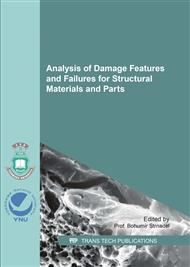p.36
p.42
p.50
p.57
p.63
p.70
p.76
p.82
p.88
Combination Criterion for Multiple Laminar Flaws in Steel Components
Abstract:
A laminar flaw is a planar subsurface flaw parallel to the rolling direction of the plate, where the applied stress is typically parallel to the rolling direction. The laminar flaw oriented within 10 degree of a plane parallel to the component surface is defined as a laminar flaw, in accordance with the definition of the American Society of Mechanical Engineers (ASME) Boiler & Pressure Vessel (B&PV) Code Section XI. The ASME Code provides combination criterion for multiple laminar flaws. If there are two or more laminations, these laminations are projected to a single plane and, if the separation distance of the projected laminations is less than or equal to 25.4 mm, the laminations shall be combined into a single large laminar flaw in the assessment. The combination criterion was established on the basis of the non-destructive examination capabilities in the 1970’s. However, this methodology did not consider the offset distance of the laminations nor the mechanical interaction between the flaws. Therefore that combination methodology is not suited in case of a large number of laminar flaws. This may occur e.g. in case of hydrogen flaking in steel forging components. Actually, when multiple discrete laminar flaws are close to each other, interaction between the flaws has to be taken into account and these flaws shall be combined to a single laminar flaw for assessment. Stress intensity factor interactions for inclined laminar flaws were analyzed in the frame of hydrogen flaking issue in reactor pressure vessels of Doel 3 and Tihange 2 Belgian nuclear power plants. Based on the mechanical interaction between flaws, new combination criterion was developed and was presented in this paper.
Info:
Periodical:
Pages:
63-69
Citation:
Online since:
June 2017
Authors:
Price:
Сopyright:
© 2017 Trans Tech Publications Ltd. All Rights Reserved
Share:
Citation:


